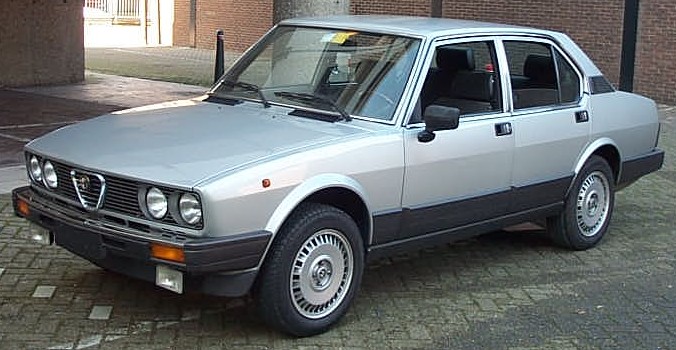1970-1977 Montreal
The Alfa Romeo Montreal is a 2+2 coupé sports car produced by the Italian manufacturer Alfa Romeo from 1970 to 1977.
Production was split between the Alfa Romeo plant in Arese and Carrozzeria Bertone's plants in Caselle and Grugliasco outside Turin. Alfa Romeo produced the chassis and engine and mechanicals and sent the chassis to Caselle where Bertone fitted the body. After body fitment, the car was sent to Grugliasco to be degreased, partly zinc coated, manually spray painted and have the interior fitted. Finally, the car was returned to Arese to have the engine and mechanicals installed. It is worth noting that because of this production method, there is not necessarily any correspondence between chassis number, engine number and production date.
The Montreal remained generally unchanged until it was discontinued in 1977. By then, production had long ceased already as Alfa were struggling to sell their remaining stock. The total number built was around 3900.
1972-1983 Alfasud
The Alfa Romeo Alfasud (Type 901, 902 and 904) was a small family car, manufactured from 1971 to 1989 by Industria Napoletana Costruzioni Autoveicoli Alfa Romeo-Alfasud S.p.A of Italy, a new company owned by Alfa Romeo and Finmeccanica. The company was based in the poor southern region of Italy as a part of the labour policy of the government.
It is considered one of Alfa Romeo's most successful models, with 893,719 examples sold between 1972 and 1983, plus 121,434 Sprint coupé versions between 1976 and 1989. A common nickname for the car is ’Sud. The car went through two facelifts, the first in 1977 and the second one in 1980.
1972-1984 Alfetta saloon
The Alfa Romeo Alfetta (Tipo 116, meaning "Type 116") was an executive saloon and fastback coupé car produced by the Italian manufacturer Alfa Romeo from 1972 to 1987. It was popular due to its combination of a modest weight with powerful engines, selling over 400,000 units until the end of its production run.
1974-1987 Alfetta GT/GTV
The Alfetta saloon was the base for the Alfetta GT, a 2-door, 4-seater fastback coupé designed by Giorgetto Giugiaro at Italdesign. Introduced in 1974, similarly to the saloon it was initially available only with the 1.8-litre (1,779 cc) version of the Alfa DOHC four.[23] These engines featured a chain driven 8-valve twin overhead cam cylinder head of cross-flow design. For 1976, with the final phasing out of the earlier 105 Series (GT 1300 Junior and GT 1600 Junior and 2000 GTV), the Alfetta GT became a range; the 1.8 was discontinued in favour of the 1.6-litre (1,570 cc) Alfetta GT 1.6 and 2.0-litre (1,962 cc) Alfetta GTV 2.0. At the same time some updates were introduced, such as a new front grille with horizontal slats and two series of vents beneath it. The GTV was distinguished from the 1.6 version by twin chrome whiskers in the grille and GTV scripts carved in the ventilation vents on the C-pillar.
1976-1989 Alfasud Sprint
The Alfa Romeo Alfasud Sprint (later only Alfa Romeo Sprint) is a boxer-engined coupé produced by the Italian manufacturer Alfa Romeo from 1976 to 1989, and based on the Alfa Romeo Alfasud. 116,552 units of the Alfasud Sprint and Sprint were built in total. The Sprint was sold in Europe, South Africa, Australia, and New Zealand.
1977-1985 Nuova Giulietta
The Alfa Romeo Giulietta (Tipo 116, Italian for Type 116) is a small executive saloon car manufactured by Italian car maker Alfa Romeo from 1977 to 1985. The car was introduced in November 1977 and while it took its name from the original Giulietta of 1954 to 1965, it was a new design based on the Alfa Romeo Alfetta chassis (including its rear mounted transaxle). The Giulietta went through two facelifts, the first in 1981 and the second one in 1983. All Giuliettas used 5-speed manual transmissions.
While it was a conventional three-box saloon/sedan body style, a defining point of difference was at the rear, where there was a short boot, and a small aerodynamic spoiler, integrated into the body. The Giulietta was only offered in saloon form, but there were several estate/station wagon conversions made. First out was Moretti, whose conversion appeared in the first half of 1978.
1979-1986 Alfa 6
The Alfa Romeo Alfa 6 (Type 119) is a luxury executive car produced by the Italian automaker Alfa Romeo from 1979 to 1986. Its name refers to the six cylinders of the Alfa Romeo V6 engine, which made its first appearance on this car.
On its launch in 1979, the Alfa 6 was the flagship of the Alfa Romeo range. The four-door body was fairly conventional and used a similar style to the existing Alfa Romeo Alfetta, and in fact both vehicles share a great number of parts, including door panels; Design work on the 6 was done prior to the Alfa Romeo Alfetta, but the fuel crisis of 1973 delayed further development and led to the 6's belated 1979 debut. The styling was not particularly aerodynamic but the drag coefficient was a somewhat respectable 0.41. Power came from an all-new 2.5 V6 engine which generated 158 PS (116 kW; 156 hp) at 5600 rpm using a total of six carburettors and a single, belt driven camshaft in each cylinder head. Power steering, power windows, central locking, electric wing mirrors and a 25% limited slip differential were standard, making the Alfa 6 competitively priced compared to similar saloons of that time where such equipment typically was a costly extra. The car was also designed to set new standards in safety; for example it featured a shock sensor in the boot which would cut off the fuel supply in the event of a crash.








.jpg/800px-1978_Alfa_Romeo_Alfetta_GTV_(7254572400).jpg)

.jpg/800px-Alfa_Romeo_Alfetta_(8106303275).jpg)

.jpg/1024px-Alfa_Romeo_(3757437527).jpg)

.jpg/800px-1983_Alfa_Romeo_Alfasud_Sprint_(6981573552).jpg)













.jfif)


No comments:
Post a Comment